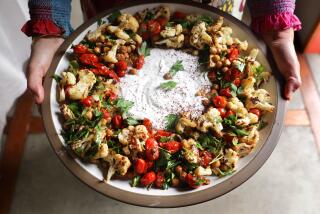High-Calorie Dressing Can Add Sodium, Fat to the Salad Days
- Share via
Don’t feel too self-righteous about your salad habit. Certain dressings can sabotage your diet so completely that you may as well eat bonbons.
“Two tablespoons of regular dressing--a typical serving--can have as many calories as a Hershey Bar, as much fat as two slices of Domino’s Pepperoni Pizza, and as much sodium as a handful of pretzels!”
That unwelcome news comes from researchers at the Center for Science in the Public Interest, which just released a nutritional study and ranking of commonly-used salad dressings.
First the bad news.
* If you consume a bottle of dressing every week--not an uncommon American habit--”half of your total fat allowance could be coming from dressing alone,” according to the center’s calculations.
*”Regular dressings can be 90% or more fat,” explains Bonnie Modugno, a Marina del Rey dietitian who agrees with CSPI’s findings. One of the “boobie prizes” in the CSPI’s rating went to Newman’s Own dressing, which gets nearly 100% of its total calories from fat.
* You can’t always depend on salad dressing labels as a barometer of nutrition. Although dressings can be labeled “reduced calorie” if they have at least one-third fewer calories than the regular version, these “lite” dressings can still pack nearly as much fat as regular dressings.
*Salad dressing labels often list one tablespoon as a serving. Truth is, most of us pour on at least two tablespoons.
But a little smarts can go a long way when you’re shopping in the salad dressing aisle. To determine whether a salad dressing is as sinful as candy, look for a brand that has no more than two grams of fat per one-ounce (two-tablespoon) serving and keeps sodium to less than 300 milligrams per serving, the center recommends.
If all else fails, stick to the 11 salad dressings listed as “best bites” by the CSPI in the accompanying chart.
Cold Hands Called Common, Not Serious
Are your hands always cold? It’s a fairly common but rarely serious condition, says Dr. Thomas Shook, a cardiologist who directs the coronary care unit at the Hospital of the Good Samaritan.
People with cold hands often have a normal body temperature but lower skin temperature, says Shook, who suspects cold-handed people may simply be more sensitive to temperature changes.
Cold hands are not usually a sign of an underlying problem like abnormal circulation, Shook says. But rarely, cold hands may be a symptom of Raynaud’s phenomenon, a condition in which the hands turn white, then blue, then red.
“Raynaud’s by itself is not serious,” Shook says, “but it can be associated with more troublesome conditions like scleroderma, a skin disorder, or drug allergies.”
Short of gloves and hand-warmers, there’s not much for cold-handed people to do, Shook says. Except maybe find solace in the old “cold hands, warm heart” theory.
As a Flirt, How Do You Rate With Others?
Ever wonder how you stack up as a flirt?
To find out, you can compare your behavior with the findings of Barbara Montgomery, a University of New Hampshire professor who recently asked more than 400 people--one-third of whom were married, two-thirds of whom were not--to share intimate details of their flirting habits.
“Most people flirt a couple of times a day,” says Montgomery, an associate professor of communication. But some of her survey respondents, who ranged in age from 17 to 70, flirted only two or three times a year. Some claimed 30 flirting episodes a day.
Who flirts? Montgomery’s study shows that singles are bigger flirters than married people, but younger people aren’t any more likely to flirt than older people and men aren’t any more likely to flirt than women.
Montgomery’s study did debunk one common flirting stereotype.
“Subjects flirted more with people they knew than with strangers,” she wrote in her study. The most likely targets of flirts, ranked in order, are acquaintances, friends, romantic partners and, finally, strangers.
The wink--an old standard flirting technique--is passe. Too overt, Montgomery says. Good flirters are likely to rely instead on stares, laughs, jokes or blushes to communicate attraction.
“The real trick about successful flirting is to keep it ambiguous,” she says. “Keep the other person wondering. Just suggest the possibility of attraction. See if the other person reacts. That gives you an out if he or she isn’t attracted.”
But her study did have one serious conclusion: “Women are more likely to put a friendly spin on flirting while men put a sexual spin on it,” says Montgomery. “That can lead to some problems with date rape or sexual harassment.”
LOW-FAT, LOW-SODIUM SALAD DRESSINGS These salad dressings have less than two grams of fat and less than 280 milligrams of sodium in a two-tablespoon serving.
Gourmet Garnishes Reduced Calorie (20 to 28 calories).
Pritikin No Oil (13 to 36 calories).
Good Seasons No-Oil Italian Mix (12 calories).
Cook’s Classic Oil-Free Italian Garlic Gusto (16 calories).
Heins Oregon Trail Mary’s Thin (6 calories).
Pfeiffer Frenchette French (20 calories).
Barondorf’s (8 to 24 calories).
Walden Farms Reduced-Calorie, Sodium-Free Italian (18 calories).
Kraft Catalina Reduced Calorie (32 calories).
Wish Bone Lite Russian (50 calories).
Richard Simmons Oriental or French (26 calories).
Source: Center for Science in the Public Interest.
More to Read
Eat your way across L.A.
Get our weekly Tasting Notes newsletter for reviews, news and more.
You may occasionally receive promotional content from the Los Angeles Times.










